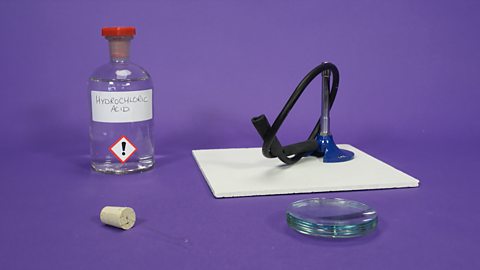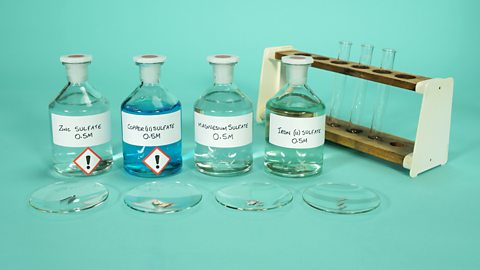What are the key learning points about prescribed practical C1?
A hydrated solid contains water of crystallisationWater that is chemically bonded into a crystal structure.. This water can be removed by gentle heating with a Bunsen burner.
By heating and weighing some solid until the massThe amount of matter an object contains. Mass is measured in kilograms (kg) or grams (g). no longer decreases (heating to constant mass), the mass of water in the hydrated crystals can be determined.
What is the purpose of prescribed practical C1?
A hydrated solid contains water of crystallisation.
This is water which is chemically combined to the crystal structure.
If we heat a hydrated solid gently, the water will be released and the solid will lose mass.
In this experiment, a hydrated solid is heated to remove the water of crystallisation.
By weighing the solid before and after heating, you can calculate the mass of water that present in the hydrated compoundA pure substance made from two or more elements which are chemically bonded in a fixed ratio. .
An example of a hydrated compound that can be used in this experiment is hydrated iron(II) sulfate:
FeSO4·xH2O
What apparatus and chemicals are needed for this practical?
Hydrated iron(II) sulfate, FeSO4.xH2O (1.30 g – 1.50 g)
Spatula
Bunsen burner, tripod and pipe clay triangle
Heat-proof mat
Crucible
Tongs
Electronic balance
What are the safety considerations involved in this practical?
Gentle heating should be carried out to reduce the risk of the iron(II) sulfate decomposedIf a substance decomposes, it breaks down into simpler compounds or elements.; use a well-ventilated lab.
Iron(II) sulfate is harmful - wear safety goggles.
Take care when heating, all apparatus will become very hot.
What are the steps involved in carrying out practical C1?
Weigh an evaporating basin, record this massThe amount of matter an object contains. Mass is measured in kilograms (kg) or grams (g). value in your results table.
Add between 1.30 g and 1.50 g of hydrated iron(II) sulfate crystals, FeSO4·xH2O. Reweigh the evaporating basin, and record the new mass in the results table.
Place the evaporating basin containing the hydrated iron(II) sulfate crystals on the gauze and gently heat for two minutes.
Allow to cool and weigh the evaporating basin and its contents, then record the mass.
Reheat the evaporating basin and its contents and reweigh, record the new mass.
Continue reheating and reweighing until the mass does not decrease any further. This process is known as ‘heating to constant mass’ and ensures that all the water of crystallisationWater that is chemically bonded into a crystal structure. has been removed from the hydrated crystals.
What observations can be made about practical C1?
Steam is given off from the hydrated solid as it is heated.
There can be a colour change in the hydrated solid.
The crystals in the hydrated solid can break down into to a powder.
What should the results table look like?
| Reading | Mass / g |
|---|---|
| Mass of empty crucible | |
| Mass of empty crucible, and crystals | |
| Mass after 1st heating | |
| Mass after 2nd heating | |
| Mass after 3rd heating | |
| Mass after 4th heating |
How should the analysis of data be presented?
Analysis of data
Mass of hydrated crystals __________________________g
Mass of anhydrous crystals __________________________g
Mass of water of crystallisation __________________________g
WATCH: How to determine the mass of water in hydrated crystals
Determine the mass of water in hydrated crystals.
How much do you know about practical C1?
More on Unit 3: Prescribed practicals
Find out more by working through a topic
- count2 of 9

- count4 of 9

- count5 of 9
